If you were wandering near the east gate of Calvary Cemetery in Evanston, Illinois you might notice the following tombstone:
Typically when a person dies, their body is laid into a grave, crypt or niche tomb and remains in that spot permanently. You can't tell from looking at this tombstone that this is actually the fourth resting place for Edward Hines, Jr. Let's take a look into his life and death and see if we can figure out why he had so many different resting places.
Edward Hines, Jr. was born July 24, 1896 in Chicago, Illinois. He was the first of three sons born to Edward Hines, Sr. (1863-1931) and Loretta O'Dowd Hines (1873-1938). The other two sons were Ralph John Hines (1900-1950) and Charles Moody Hines (1901-1979). There was also a daughter, Loretta Margaret/Mrs. Howell Hoffman Howard (1904-1982).
The Hines Family were long-time Evanstonians and devout Roman Catholics. Very well known to Chicagoans, Edward Hines, Sr. was called "The Lumber King". The Hines Lumber Company maintained a large facility in Evanston on Church Street until it was destroyed by a devastating fire on March 8, 1970.
I was unable to find the Edward Hines family in the 1900 US Census, but it was easy to find them in the 1910 US Census. The family was living at 1456 Ridge Avenue in Evanston, Illinois:
 |
| 1456 Ridge Avenue, Evanston |
The family consisted of Edward Hines (47 years old), his wife Loretta (38), and their four children: Edward Hines, Jr. (14), Ralph (9), Charles (8), and Loretta (5). Edward Hines, Sr. listed his occupation as "President of a Lumber Company;" the others listed no occupations. In addition to the Hines family, there were eight servants: Marie Samesk (Cook), Anna Jensen (Cook), Tina Torisen (Nurse), Gussie O' Nash (Servant), Sarah Kirby (Nurse), John Geskal (Chauffeur), Stephen Gail (Chauffeur), and Vera Masek (Nurse). I do not know why it was necessary to have three nurses living with them since there were no infants; perhaps Mrs. Hines was in poor health.
Edward Hines, Jr. attended elementary school in Evanston then to Philips Academy in Andover, Massachusetts for high school. He entered Yale University in the fall of 1915, taking up the Sheffield Scientific Course, and was in his second year when he entered First Officers’ Training Camp at Fort Sheridan, where he was assigned to the Third Company. Upon receiving a commission as second lieutenant he was ordered to the 4th Machine Gun Battalion, Gettysburg, Pa., sailing with that outfit for France on December 24, 1917.
Edward Hines, Jr. loved being in the military and was well-respected. After a few months’ service overseas Lieutenant Hines was promoted to a first lieutenancy.
The first indication of a problem with young Hines was reported in the Chicago Tribune on April 24, 1918:
An update (although not a good one) was reported in the Tribune on May 3, 1918:
Things were starting to look better as reported by the Tribune on May 12, 1918:
Edward Hines, Jr. had not been wounded but this was wartime and first reports often ended up being incorrect.
Two weeks later, on May 25, 1918 Hines had taken a turn for the worse:
Lieut Edward Hines, Jr. Critically Ill in France
"Lieut Edward Hines, Jr., in critical condition. Little hope for his recovery."
This message bearing news of his condition "over there" was received by Edward Hines of 1452 Ridge avenue, Evanston yesterday. Mr. Hines last night said he has been receiving disheartening information of his son's condition for the last two weeks.
Lieut. Hines was attacked by rheumatism after two weeks' active service in the trenches. He was removed to a base hospital, but continued to grow worse. A few days ago he fell a victim also to pneumonia. Lieut. Hines is 21 years old.
An update was in the Tribune of May 29, 1918. Things were extremely grave:
One June 2, 1918 it was reported that young Hines was paralyzed on 1/2 of his body:
A temporary wooden hospital had been built at Fort Sheridan but Hines was proposing to fund a permanent hospital in Maywood. It may be hard to believe, but there was a tremendous amount of opposition to the Hines plan, mostly due to the Maywood location.
Meanwhile, Edward Hines, Jr. is resting in peace in his grave in France - or is he?
This is from the Chicago Tribune from May 23, 1919:
"Mrs. Hines declined to discuss a report that she has been successful in having the body of her son...sent back from France."
By September of 1919, Mrs. Hines was ready to admit to the public that she had, in fact, had her son disinterred from his grave in France and that it would be reinterred in Calvary Cemetery in Evanston. To try to address any negative publicity, Edward Hines explained their actions in the Chicago Tribune from September 17, 1919:
This is what the Tribune reported on September 21, 1919:
But even at that time the family was not sure where the final resting place for Lieutenant Hines would be. Temporarily he was interred in the John Cudahy family mausoleum at Calvary.
Here is a photo of the Hines family standing on the steps of the Cudahy Mausoleum after Edward Hines Jr.'s body was temporarily placed there:
 |
| Author's Collection |
The Cudahy Mausoleum at Calvary Cemetery was the second grave of Edward Hines, Jr.
On October 24, 1921, Treasury Secretary Andrew Mellon issued the official order that renamed Public Health Hospital No. 76 as the Edward Hines, Jr. hospital. Hines Sr's long fight against the hospital opponents was finally won. Here is how the entrance to Hines VA Hospital looks today:
There is a plaque in the lobby that explains how the hospital came to be named for Edward Hines, Jr.:
As mentioned earlier, Edward Hines and his family were devout Catholics. Hines could always be relied upon to write a sizable check for any Catholic cause that needed funds. In 1915, Archbishop George Mundelein (later Cardinal) of Chicago purchased 600 acres in the suburb then known as Area, Illinois to re-establish the Archdiocese's University of Saint Mary of the Lake, also known as the Mundelein Seminary.
In 1926, the seminary opened a new campus church, designed by Chicago architect Joseph W. McCarthy. The institution became known throughout the world in 1926 as the site for the 28th International Eucharistic Congress. Edward Hines had donated $500,000.00 to Cardinal Mundelein's seminary project, so it was decided that there needed to be some recognition of Hines' generosity. It is not known who first came up with the idea, but it was decided as part of the 1925 improvements to the seminary to construct a private interment space to house the remains of Edward Hines, Jr.
Edward Hines, Jr.'s remains were removed from the Cudahy Mausoleum at Calvary Cemetery and reinterred on the grounds of St. Mary of the Lake on November 8, 1925 (some sources incorrectly say 1926). Here is an article about the transfer from the Lake County (IL) Register of November 11, 1925:
I wrote to her and asked if she knew why the remains of Edward Hines, Jr. were moved. She never responded to my inquiry.



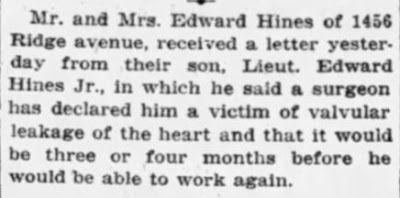



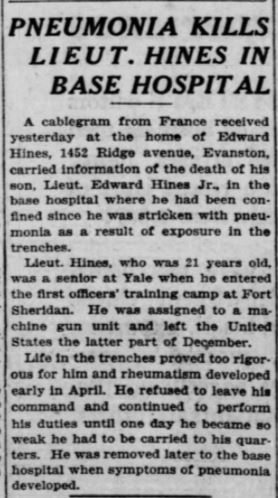




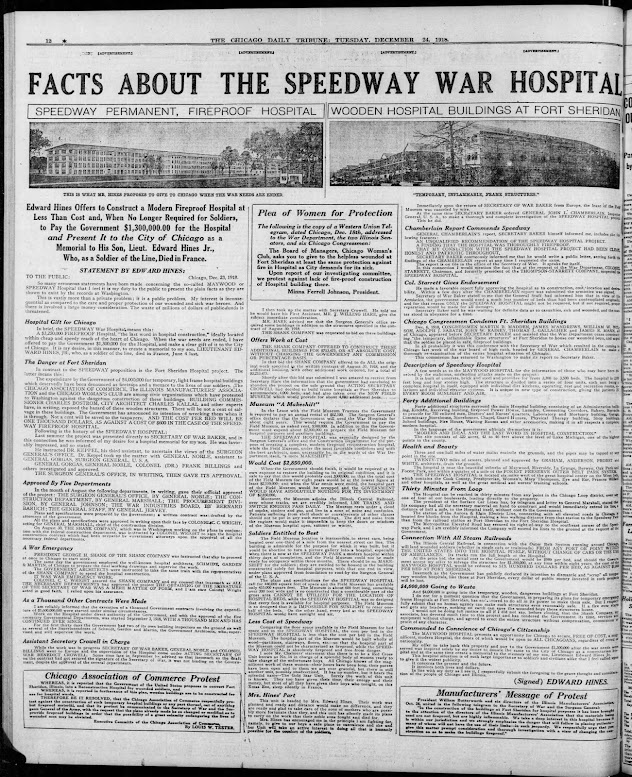
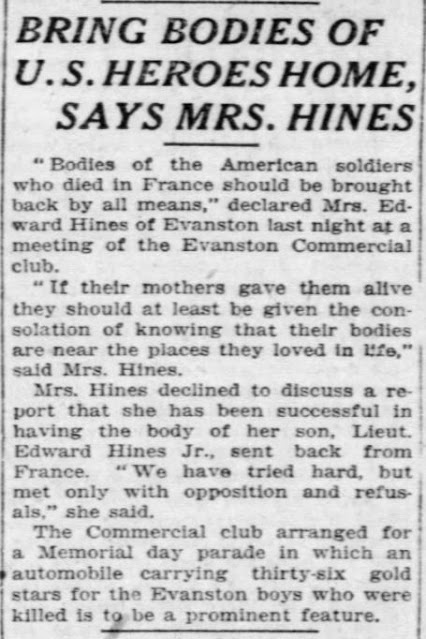
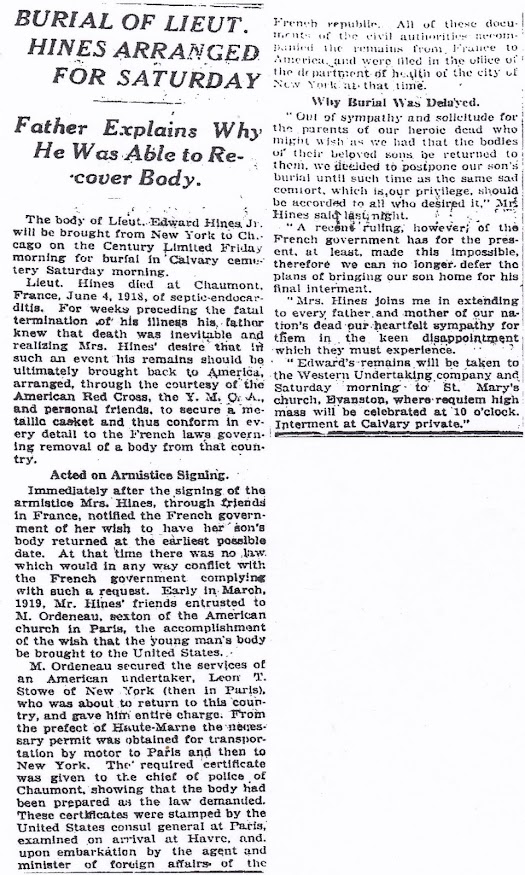
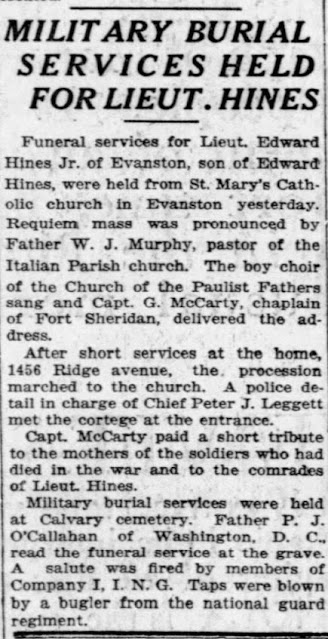



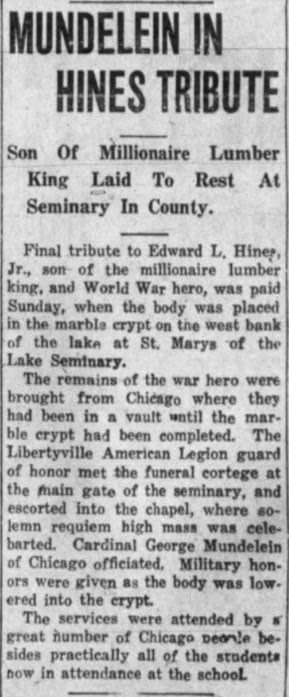









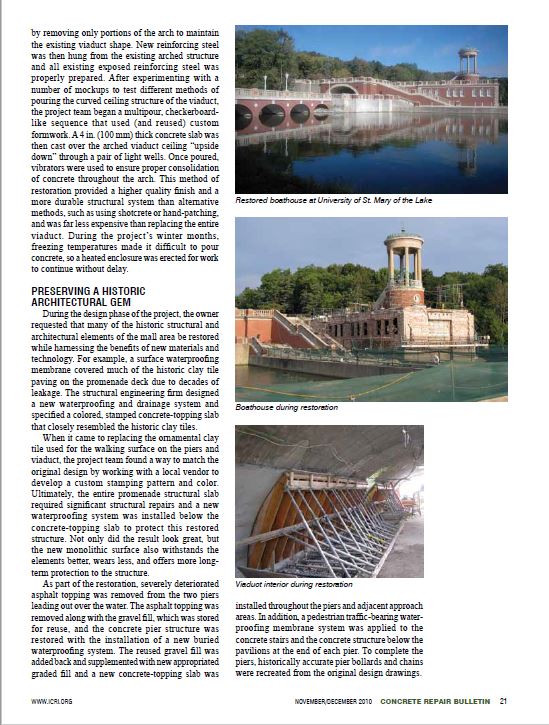




The full size painting of Hines was also found at the Hines company office. I am not sure if it was the same one that you saw. Likely it was moved after the company was sold. Maybe there were several copies made? My father worked for Ed Hines Jr who died in 2015, the nephew of the soldier who died in 1918
ReplyDelete